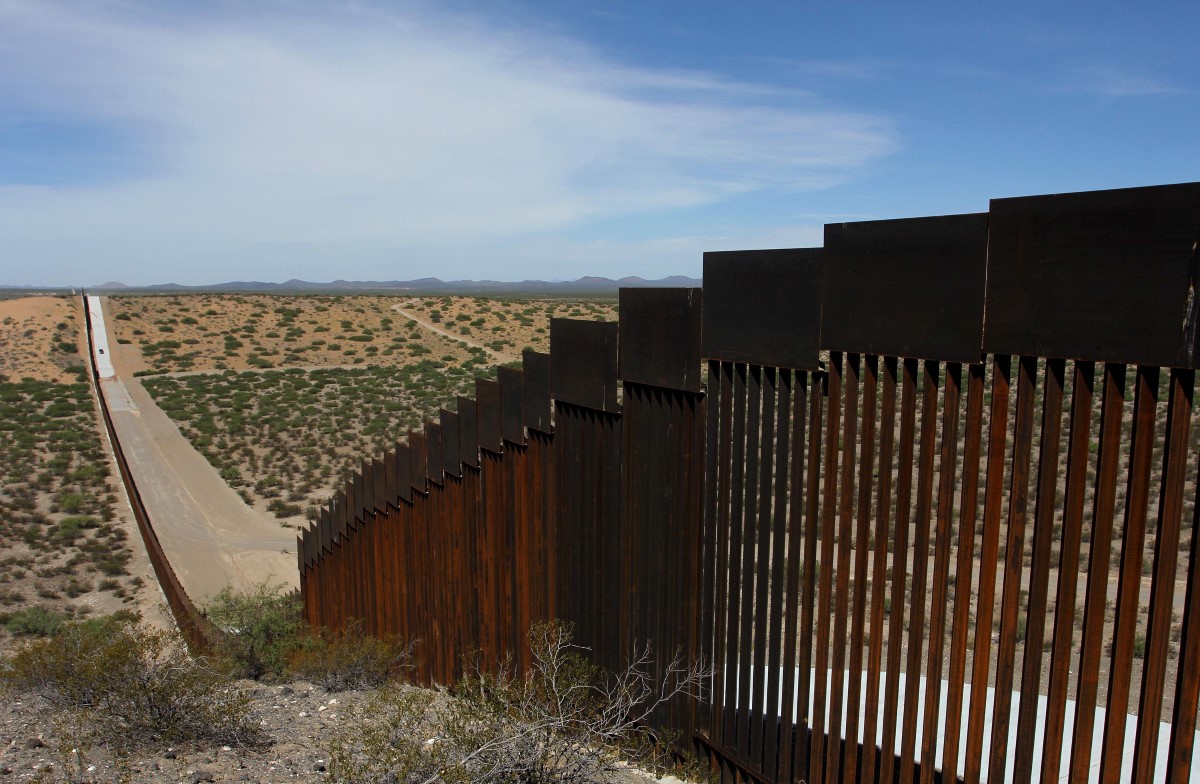

Articles
How Long Is The US Mexico Border Fence
Modified: October 18, 2024
Discover the length of the US-Mexico border fence and get insights on its impact. Read articles on this contentious issue and stay informed.
(Many of the links in this article redirect to a specific reviewed product. Your purchase of these products through affiliate links helps to generate commission for Storables.com, at no extra cost. Learn more)
Introduction
The US-Mexico border fence is a prominent physical barrier that stretches across the southern border of the United States. It is a symbol of the ongoing efforts to regulate immigration and combat drug smuggling, as well as a point of contention and debate.
Spanning approximately 1,954 miles, the US-Mexico border is one of the most heavily trafficked borders in the world. Over the years, the border region has faced numerous challenges related to illegal immigration, drug trafficking, and other illicit activities. In an attempt to address these issues, the construction of a border fence became a focal point for policymakers.
The purpose of this article is to explore the historical background of the US-Mexico border fence, delve into its construction, examine the challenges and controversies surrounding it, evaluate its effectiveness, and explore alternative approaches to border security.
It is important to note that the intention of this article is not to provide a definitive solution to the complex issues of immigration and border security, but rather to present a comprehensive analysis of the US-Mexico border fence and its impact.
By gaining a thorough understanding of the border fence and its implications, we can contribute to informed discussions and decision-making regarding border security policies.
Key Takeaways:
- The US-Mexico border fence, spanning 1,954 miles, has reduced unauthorized crossings but faces challenges. A comprehensive approach, including technology, diplomacy, and economic development, is crucial for effective border security.
- While the border fence has had some impact, it’s not a definitive solution. Alternative strategies such as comprehensive immigration reform, collaboration with neighboring countries, and advanced technology offer more holistic and humane approaches to border security.
Read more: How Long Are Fence Panels
Historical Background
The history of the US-Mexico border fence dates back to the mid-20th century when concerns about illegal immigration and smuggling activities began to surface. In 1945, the US Border Patrol implemented Operation Wetback, a large-scale crackdown on undocumented immigrants crossing the border from Mexico. However, this operation fell short of effectively addressing the issue.
In the 1990s, several key events contributed to the push for the construction of a physical barrier along the US-Mexico border. The adoption of the North American Free Trade Agreement (NAFTA) in 1994 resulted in increased economic integration between the two countries, leading to heightened cross-border movement of goods and people. This, in turn, led to concerns about illegal immigration and the need for improved border security measures.
The Illegal Immigration Reform and Immigrant Responsibility Act of 1996 further fueled the debate. This legislation, signed into law by President Bill Clinton, called for increased border enforcement and facilitated the construction of barriers in certain areas of the border.
The events of September 11, 2001, also played a significant role in shaping the discourse around border security. The attacks highlighted the vulnerabilities of the US immigration system and raised concerns about potential terrorist threats entering the country illegally. As a result, the call for stricter border control measures gained even more traction.
In 2006, the Secure Fence Act was passed, paving the way for the construction of a physical barrier along certain sections of the US-Mexico border. This legislation was accompanied by a significant increase in border patrol agents, as well as the deployment of technology such as surveillance drones and advanced monitoring systems.
Since then, the border fence has been a widely debated issue, with proponents arguing for its effectiveness in deterring unauthorized crossings and opponents questioning its cost, environmental impact, and overall efficacy in addressing the complex challenges of border security.
While the historical context provides insights into the factors that led to the construction of the border fence, it is important to delve deeper into its implementation and consequences to gain a more comprehensive understanding of its impact.
Construction of the Border Fence
The construction of the US-Mexico border fence began in 2007 and involved a combination of physical barriers, including walls, fences, and vehicle barriers. The objective was to create a more secure and controlled border, with the aim of deterring unauthorized crossings and curbing illicit activities.
The fence was constructed in segments along different sections of the border, focusing on areas with high levels of illegal immigration and smuggling. It involved a variety of materials, including reinforced metal mesh, concrete, and steel beams.
The border fence project faced numerous logistical challenges due to the diverse terrain and environmental considerations. For instance, stretches of the border traverse rugged mountain terrain, deserts, rivers, and private properties, requiring careful planning and coordination with various stakeholders.
The construction of the border fence was a massive undertaking, involving the allocation of significant resources. The cost of the fence varied depending on the location and materials used, with estimates ranging from billions to tens of billions of dollars.
Throughout the construction process, several legal challenges were raised by environmental groups, landowners, and Native American tribes. These groups argued that the construction of the border fence would have a detrimental impact on wildlife habitats, disrupt natural ecosystems, and encroach upon sacred lands. Legal battles ensued, resulting in delays and modifications to the original plans.
Despite the controversies and logistical hurdles, significant portions of the US-Mexico border are now lined with physical barriers. However, it is essential to note that the border fence is not continuous and stretches of the border remain unfenced, primarily due to geographical constraints and land ownership issues.
It is important to acknowledge that the construction of the border fence is an ongoing process, with periodic expansions and modifications being made over the years. The evolution and expansion of the fence have been influenced by changing political climates and shifts in border security priorities.
While the construction of the border fence may be seen as a tangible response to the challenges posed by unauthorized crossings and smuggling, its impact and effectiveness continue to be subjects of debate.
Challenges and Controversies
The US-Mexico border fence has been the subject of intense scrutiny and debate since its inception. Supporters argue that the border fence is a crucial component of national security, serving as a deterrent to unauthorized border crossings and illicit activities such as drug trafficking. However, there are numerous challenges and controversies surrounding its implementation and effectiveness.
One major controversy involves the human cost of the border fence. Critics argue that the construction of the fence has resulted in the disruption of communities, separation of families, and violations of human rights. The fence has affected the lives of individuals living on both sides of the border, leading to strained relationships between neighboring communities.
Environmental concerns have also been raised regarding the border fence. The construction of physical barriers has had significant impacts on wildlife habitats, migration patterns, and ecosystems. The fragmentation of habitats and the disruption of natural corridors have raised concerns among environmentalists, who argue that the fence is harming biodiversity and threatening endangered species.
Another contentious issue related to the border fence is its cost-effectiveness. Critics argue that the financial resources allocated to the construction and maintenance of the fence could be better utilized in other areas of border security, such as technology upgrades, intelligence gathering, and cooperation with Mexico. They argue that a comprehensive and multi-faceted approach to border security would yield better results than a reliance solely on physical barriers.
The border fence has also faced challenges in terms of its overall effectiveness. Critics contend that determined individuals can find ways to bypass or overcome physical barriers, rendering them ineffective in deterring unauthorized crossings. They argue that focusing on comprehensive immigration reform and addressing the root causes of migration would be a more practical and humane approach to border security.
The border fence has also strained diplomatic relations with Mexico. Critics argue that the construction of the fence sends a message of hostility and mistrust to the neighboring country. They contend that collaboration and cooperation with Mexico, along with addressing the underlying issues of poverty, violence, and corruption, would be more beneficial in addressing the challenges posed by unauthorized migration and cross-border crimes.
These challenges and controversies highlight the complex nature of border security and the need for a more nuanced approach. It is essential to evaluate the effectiveness and repercussions of the border fence, while considering alternative strategies that focus on comprehensive immigration reform, collaboration with neighboring countries, and addressing the root causes of migration.
The US-Mexico border fence stretches for approximately 654 miles, with various types of barriers including fencing, vehicle barriers, and walls.
Effectiveness of the Fence
The effectiveness of the US-Mexico border fence in achieving its intended objectives remains a topic of debate. Supporters argue that the physical barriers have contributed to a reduction in illegal border crossings and have acted as a deterrent for unauthorized migration and smuggling activities.
Proponents of the fence point to statistics showing a decline in apprehensions at certain sections where the fence has been built. They argue that the presence of physical barriers forces individuals to seek alternative and often more dangerous routes, thereby discouraging illegal border crossings.
However, critics argue that the decline in apprehensions cannot solely be attributed to the border fence. They contend that a combination of factors, including enhanced technology, increased border patrol agents, and economic conditions, contribute to fluctuations in unauthorized crossings.
Moreover, critics argue that the construction of the border fence has led to a shift in migration patterns, rather than a complete halt or a significant reduction. Individuals seeking to enter the United States may adapt their strategies and find alternative routes, such as underground tunnels or utilizing smugglers to bypass the physical barriers.
Additionally, the cost of the border fence has come under scrutiny in relation to its effectiveness. Critics argue that the significant financial resources invested in the construction, maintenance, and surveillance of the fence could be more efficiently allocated to other forms of border security measures, such as improved technology, intelligence gathering, and cooperation with Mexico.
Furthermore, critics argue that the border fence has unintended consequences, such as the disruption of wildlife habitats, violation of human rights, strain on diplomatic relations, and the diversion of resources from addressing the root causes of migration. They advocate for a more comprehensive and multifaceted approach to border security that includes addressing economic disparities, promoting regional cooperation, and implementing comprehensive immigration reforms.
While the border fence has undeniably had some impact on unauthorized border crossings and smuggling activities, its overall effectiveness is a subject of ongoing debate. The complexities of border security issues necessitate a comprehensive and balanced approach that combines physical barriers, technological advancements, intelligence gathering, collaboration with neighboring countries, and addressing the underlying economic, social, and political factors that drive unauthorized migration.
It is crucial to continue evaluating the effectiveness of the border fence and exploring alternative strategies to ensure a more secure and humane approach to border security.
Read more: How Long For Fence Stain To Dry
Alternatives to the Border Fence
While the US-Mexico border fence has been a focal point of border security efforts, there are alternative approaches that can be explored to address the challenges posed by unauthorized migration and illicit activities. These alternatives aim to provide more comprehensive and sustainable solutions while considering the complexities of border security and immigration issues.
1. Comprehensive Immigration Reform: Many argue that focusing on comprehensive immigration reform is essential to addressing the root causes of unauthorized migration. This approach involves creating a pathway to legal status for undocumented immigrants already in the country, improving legal immigration channels, and addressing the economic, social, and political factors that drive migration through cooperation with source countries.
2. Collaboration with Mexico and Central American Countries: Enhancing cooperation with Mexico and countries in Central America is crucial in tackling the challenges at the source. Investing in economic development, supporting governance and rule of law, and addressing violence and corruption in these regions can help reduce the push factors that drive migration.
3. Smart Border Technology: Instead of relying solely on physical barriers, investing in advanced technology can enhance border security efforts. This includes the use of drones, surveillance cameras, motion sensors, and advanced data analytics to increase situational awareness and detect unauthorized crossings more efficiently. Technology can provide real-time monitoring and response capabilities without the high costs and environmental impact associated with physical barriers.
4. Enhanced Border Patrol and Intelligence Gathering: Strengthening border patrol forces, equipping them with the latest technology, and increasing intelligence sharing can improve security along the border. This can include investing in training and resources for border agents, improving communication and coordination among various law enforcement agencies, and utilizing intelligence to target and disrupt smuggling networks.
5. Addressing Economic Disparities: One of the underlying factors driving unauthorized migration is economic disparity. Investing in economic development, both in the United States and source countries, can create more opportunities and reduce the need for individuals to seek better economic conditions through unauthorized means.
6. Regional Cooperation and Information Sharing: Collaborating with neighboring countries and international organizations can lead to a more coordinated and effective approach to border security. Sharing information, intelligence, and best practices can help address transnational criminal organizations, facilitate lawful trade and travel, and strengthen overall regional security.
While each of these alternative approaches has its own challenges and complexities, they offer a more holistic and multifaceted approach to border security. By investing in comprehensive reforms, cooperation, advanced technology, and addressing the root causes of migration, a more efficient and humane border security system can be developed.
It is crucial to consider these alternatives and engage in informed discussions to find solutions that balance security concerns with humanitarian considerations and promote regional stability.
Conclusion
The US-Mexico border fence has been a highly debated and controversial topic, serving as a physical symbol of the ongoing efforts to regulate immigration, combat drug smuggling, and enhance border security. However, the effectiveness and consequences of the border fence remain subjects of intense scrutiny.
While the construction of the border fence has contributed to a reduction in unauthorized border crossings and smuggling activities in certain areas, its overall effectiveness is a matter of debate. Critics argue that determined individuals will find ways to bypass or overcome physical barriers, and that a comprehensive and multifaceted approach to border security is needed.
The challenges and controversies surrounding the border fence include concerns about human rights violations, disruption of communities, environmental impacts, and strained diplomatic relations with Mexico. Additionally, the cost-effectiveness of the fence has been questioned, with some arguing that resources could be more efficiently invested in technology, intelligence gathering, and addressing the root causes of migration.
Exploring alternatives to the border fence is essential in addressing the complex issues of unauthorized migration and border security. Comprehensive immigration reform, collaboration with neighboring countries, smart border technology, enhanced border patrol and intelligence, addressing economic disparities, and regional cooperation offer alternative strategies that focus on long-term solutions.
In conclusion, the US-Mexico border fence is just one component of a broader border security strategy. While it has had some impact on unauthorized crossings and illicit activities, the fence alone is not a definitive solution. A balanced and comprehensive approach that considers economic, social, and political factors, while respecting human rights and promoting regional cooperation, is necessary to effectively address the challenges of border security.
By continuing to evaluate the effectiveness of the border fence, exploring alternative approaches, and engaging in informed discussions, policymakers can work towards developing a border security system that is both effective and humane.
Frequently Asked Questions about How Long Is The US Mexico Border Fence
Was this page helpful?
At Storables.com, we guarantee accurate and reliable information. Our content, validated by Expert Board Contributors, is crafted following stringent Editorial Policies. We're committed to providing you with well-researched, expert-backed insights for all your informational needs.















0 thoughts on “How Long Is The US Mexico Border Fence”